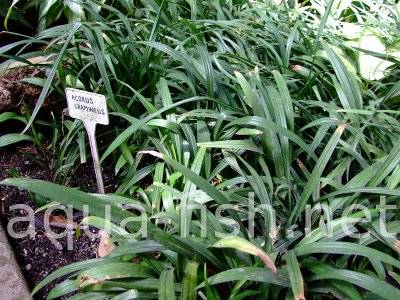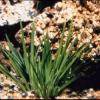Acorus gramineus
Scientific name: Acorus gramineus
Family: Acoraceae
Usual maximum size in aquariums: 15 - 30 cm (5.91 - 11.81 inch)
014
Recommended pH range for the species: 6.5 - 7.5
Recommended water hardness (dGH): 4 - 18°N (71.43 - 321.43ppm)
0°C 32°F30°C 86°F
Recommended temperature: 22 - 28 °C (71.6 - 82.4°F)
Reproduction of the plant: Rhizome
Origin (in the wild): East Asia
How fast these plants grow: Slow
Recommended substrate: Gravel
Demands on lighting: Medium
Ideal placement in a fish tank: Middle
Common Names
Dwarf Sedge, Japanese Rush, Japanese Sweet Flag
Origin
Acorus gramineus, also known as Dwarf Sedge or Japanese Sweet Flag, is native to Japan. It belongs to the Acoraceae family and is widely cultivated for its ornamental value in aquatic environments.
Planting Area
This versatile plant thrives when planted in the midground or foreground of your aquarium. Its compact size and vibrant green foliage make it an excellent addition to aquascapes of all sizes.
Propagation
Acorus gramineus reproduces through rhizomes, which are underground stems that spread horizontally to produce new plants. To propagate, carefully divide the rhizome and plant the sections in shallow water. Allow the rhizomes to acclimate and develop roots before transplanting them into the substrate.
Difficulty
Acorus gramineus is considered an easy-to-grow plant, making it suitable for beginners and experienced aquarists alike. However, it requires regular maintenance, including trimming and pruning, to prevent it from overgrowing and overshadowing other plants in the aquarium.
Lighting and Water Conditions
This plant thrives in moderate to high lighting conditions, but it can tolerate lower light levels as well. Provide a nutrient-rich substrate and supplement with liquid fertilizers to promote healthy growth. Maintain stable water parameters, including a pH range of 6.5 to 7.5 and temperatures between 72°F to 82°F (22°C to 28°C).
Uses in Aquascaping
Acorus gramineus adds texture and visual interest to aquascapes with its slender, upright leaves and grass-like appearance. It creates a naturalistic habitat for fish and provides hiding places for shy or breeding species. When planted in clusters or along the edges of the aquarium, it creates a lush, vibrant foreground that enhances the overall aesthetics of the tank.
Potential Issues
While generally hardy, Acorus gramineus may be susceptible to algae growth if light and nutrient levels are not balanced. Monitor the plant closely for signs of yellowing, browning, or decaying leaves, which could indicate nutrient deficiencies or inadequate lighting. Additionally, ensure proper water circulation to prevent stagnant areas where debris and algae can accumulate.
Overall, Acorus gramineus is a versatile and visually appealing plant that adds beauty and natural charm to any freshwater aquarium. With proper care and maintenance, it will thrive and enhance the aquatic environment for both fish and aquarists alike.



 Acorus gramineus pusillus
Acorus gramineus pusillus